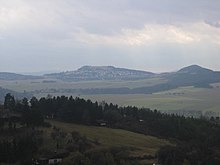Heimerad

The holy Heimerad (also Heimo , Heimrad , Haimrad ; * around 970 in Meßkirch ; † June 28, 1019 on the Hasunger Berg near Kassel ) was a German priest and traveling preacher. He evangelized in what is now northern Hesse and southern Lower Saxony . His feast day is June 28th .
Life
Its origin from Messkirch is expressly attested in an old manuscript. The young priest, who probably came from a humble background, went on pilgrimages to Germany , and when he was about 30 he went on a trip to Rome and then on a pilgrimage to Jerusalem . After his return to Germany, he wanted to become a monk in the Hersfeld monastery , but was expelled there after a dispute about wearing religious clothing. In Paderborn he was not accepted into the monastery either. He then lived as a wandering monk. Due to his unusual way of life, he was expelled from several places and became more and more neglected. Finally, he settled on the Hasunger Berg near Burghasungen in Northern Hesse and ran the Michaelskapelle there. Originally also mocked and mocked there, he was venerated as a saint over time and asked for advice by clerical and secular dignitaries. He was acquainted with Empress Kunigunde , Bishop Meinwerk of Paderborn and the Archbishop of Mainz Aribo . Heimerad died on June 28, 1019 and was buried on Hasunger Berg.
Adoration
The main source for his life is the biography which the monk Ekkebert von Hersfeld wrote between 1085 and 1090.
Archbishop Aribo had a church built on Hasunger Berg two years after Heimerad's death in 1021, which became the nucleus of a canonic monastery founded in 1074. Its conversion to Hasungen Monastery was completed in 1081. Ordinary people revered Heimerod as a saint and miracle worker. The pilgrimages to his grave reached their climax in the second half of the 11th century, when Hasungen was one of the most visited German pilgrimage sites alongside the Sebaldus grave in Nuremberg. In later centuries, especially after the introduction of the Reformation in the Landgraviate of Hesse in 1526 and the associated abolition of Hasungen Monastery, Heimerad's veneration declined radically. With the publication of his Vita in book form in 1681 and its inclusion in the Acta Sanctorum collection of saints in 1744 , Heimerad reappeared in the consciousness of many believers. In his hometown of Messkirch the saint was commemorated again, and so in 1773 the painter Meinrad von Au included him in the ceiling painting of the parish church of St. Martin .
Today the wooden Heimerad cross with a bronze plaque commemorates Heimerad's work on the Burghasunger Berg.
swell
- Ekkebert von Hersfeld: Vita sancti Haimeradi , ed. by R. Köpke, in: Annales et chronica aevi Salici. Vitae aevi Carolini et Saxonici (= Monumenta Germaniae Historica , Scriptores in folio ; Vol. 10). Hiersemann, Hannover 1852, pp. 595–612, contains Ekkebert's text and a later paraphrase ( digitized version )
literature
- Friedrich Wilhelm Bautz : Home bike. In: Biographisch-Bibliographisches Kirchenlexikon (BBKL). Volume 2, Bautz, Hamm 1990, ISBN 3-88309-032-8 , Sp. 664
- Hagen Keller : noble saint and pauper Christi in Ekkebert's Vita sancti Haimeradi. In: Josef Fleckenstein, Karl Schmid (Ed.): Nobility and Church. Gerd Tellenbach on his 65th birthday. Freiburg 1968, pp. 307-323.
- Tilman Struve : Hersfeld, Hasungen and the Vita Haimeradi. In: Archives for cultural history. Volume 51, Issue 2, 1969, pp. 210-233.
- Christoph Witt: The holy home wheel of Meßkirch. Pilgrims, priests, hermits. Gmeiner, Meßkirch 2009, ISBN 978-3-8392-1032-1 .
- Peter Ebner : Home bike. despised - loved - holy. Narrative. Sales, Eichstätt 1997, ISBN 3-7721-0197-6 .
Web links
Individual evidence
- ↑ a b c Pilgrim monk Heimrad. A saint from Messkirch . In: Schwäbische Zeitung from April 9, 2010
- ↑ a b Plger hike. Pilgrims hike the Way of St. James in honor of St. Heimrad . In: Schwäbische Zeitung from June 30, 2010
| personal data | |
|---|---|
| SURNAME | Heimerad |
| ALTERNATIVE NAMES | Heimo; Home bike; Haimrad |
| BRIEF DESCRIPTION | German priest and hermit |
| DATE OF BIRTH | around 970 |
| PLACE OF BIRTH | Messkirch |
| DATE OF DEATH | June 28, 1019 |
| Place of death | Hasunger Berg near Kassel |
